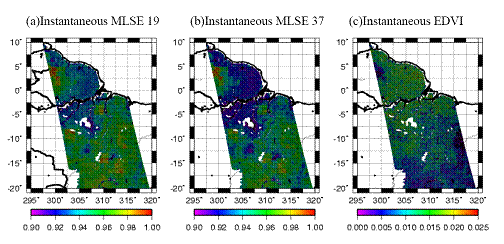Satellite remote sensing of vegetation properties
 |
| Satellite retrieved microwave land surface emissivites at 19 and 37 GHz and the Emissivity Difference Vegetation Index (EDVI) over the Amazon Basin on August 30, 2004. (Min, Lin and Li 2009, conditionally acceptted) |
"emissivity difference vegetation index" (EDVI) and evapotranspiration (ET)
The terrestrial vegetation and ecological systems play important roles in global change and climate variations. An accurate depiction of evapotranspiration (ET) and photosynthesis processes is essential in the understanding of the response and influence of the vegetation system to water, energy, and carbon cycles of the climate.
A novel technique that links vegetation properties and ET fluxes with a microwave "emissivity difference vegetation index" (EDVI) has been developed and applied to middle latitude forest region (Harvard forest) and the tropical rainforest region (Amazon). Further, we developed a physical based algorithm to estimate evapotranspiration (ET) by using satellite retrieved EDVI. This technique extends the current satellite capability of vegetation property and ET flux remote sensing from daytime, clear-sky conditions to day and night times (monitoring diurnal variations) under all weather conditions, and from intermediate leaf area index (LAI) to all range of vegetation states.
Satellite remote sensing of lantern heating profiles
Precipitation, in driving the global hydrological cycle, strongly influences the behavior of the Earth's weather and climate systems. The latent heating (LH) released through precipitation is the principal energy source in the creation, growth, vertical structure, and propagation of long-lived tropical waves. And the distinct vertical distribution properties of convective and stratiform LH profiles help influence climatic outcomes via their tight control on large-scale circulations.
We developed a retrieval algorithm of LH profiles based observed precipitation profiles from TRMM Precipitation Radar (PR) and Cloud Resolving Model (CRM), and applied our retrievals to study ENSO impacts on precipitation and associated large-scale circulation.


